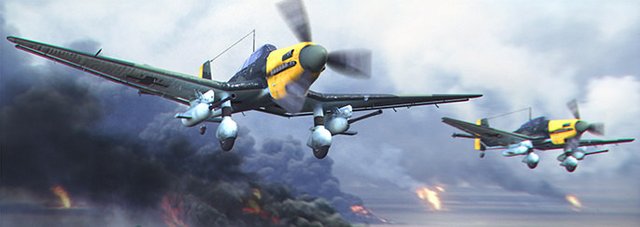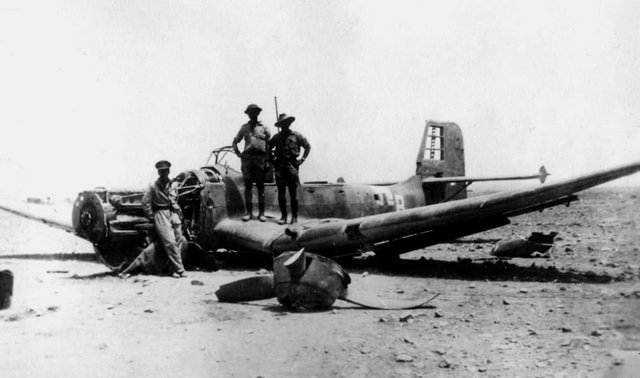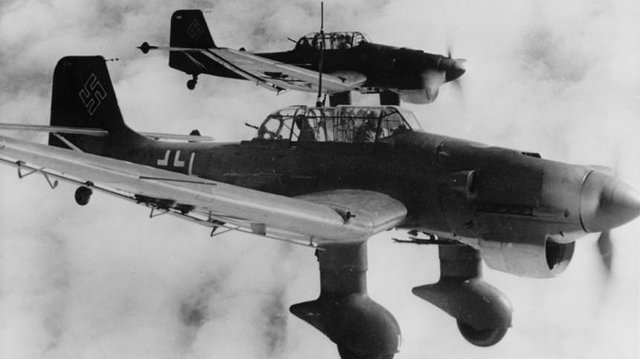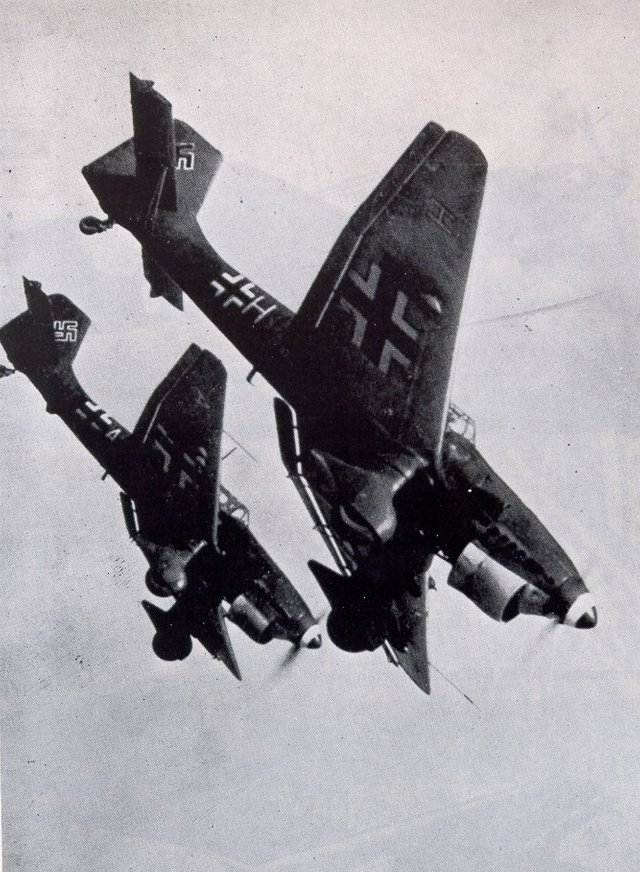Tobruk part five: The Stuka dive bomber - Junkers JU 87
"I'm proud to be an Aussie, there's something different about them. The Hun fights with grim determinations, the Tommies fight by numbers, but the Aussies tear about like kids at a picnic, swearing and laughing the whole time. They knock some bastard, then lean against a tree and roll a cigarette..." - A young Australian soldier in Tobruk to his mother.

Image source
The Diggers, were a tough bunch, highly regarded on the battlefield and renowned for lacking discipline off it. They got the job done though. They earned a reputation for getting results, and for their rebellious nature, in the First World War where they excelled on the battlefield. The Tommies, (British) were impeccably turned out and disciplined however lacked the flexibility in thought that the Aussie soldier had naturally. Tell a British soldier to pop out of the trenches and walk towards the enemy machine guns and he would do so, as would the Aussie's. But the Aussie soldier had the ability to think out of the box, as an individual. In situations where the British soldier required direction and orders, the Aussie would make it up, adapt and innovate. They were also big brutes, hard working men off the land, from harsh environments.
In World War Two their reputation preceded them and once they closed with their enemy in the deserts of Africa the Axis forces understood all too clearly how brutal these Southern Sons could be. They fought without animosity though, both sides did; They were simply there to do a job and go home.
They were pragmatic problem solvers and were used to adversity, hard work and individual thought. The Aussies in Tobruk were able to accept hand to hand combat, understood the hardships and sacrifices made on the battlefield, they could even relate to the enemy forces suffering the same baking hot temperatures and freezing nights, bullets, bombs, bayonets and bombers... Well, actually not quite.
The Australian soldiers of the Tobruk garrison hated the bombers!

After the the Easter Battle in which they defeated Erwin Rommel's attack they were subjected to relentless bombing from high-level bombers and the Stuka dive bomber. Most people are familiar with a bomber which typically is a large, relatively slow aircraft that flies over the target and disgorges a payload of bombs that fall to the ground and explode wherever they land. The Stuka was something else though. Image to the right: Aussie soldiers stand on a downed Stuka. They didn't bring down many and when they did it was a cause for great celebration. Image source
Junkers Ju 87 - The "Stuka"
The Stuka took its first flight in 1935 and saw battle for the first time in 1937 but it was at the outbreak of the Second World War when it came into it's own. It was utilised to provide close-air-support for ground troops and as an anti-shipping bomber to devastating effect. Seemingly its only downfall, like most bombers, was that it was quite slow and not very manoeuvrable so was susceptible to fighter-aircraft attack. For that reason they were always surrounded by a strong fighter-escort.
What made them so effective was their payload delivery system. The Stuka was equiped with automatic "pull-up" dive brakes that would pull a Stuka out of a steep dive even should the pilot black out from the G-force. It allowed pilots to accurately deliver their bombs to the target making them excellent against entrenched troops, shipping and even tanks.

From the height of 4,600m the pilot would put the aircraft into a dive after locating the target through the bomb-sight window in the floor of the plane. The dive would be at between 60-90 degrees, possible due to the dive breaks, and at a speed of up to 600kph. The bomb would be released at around 450m above the target and the plane would automatically perform a 6G pull-out, throttling on hard, and once the nose was on the horizon the dive breaks would retract and the pilot would resume normal flight. Ingenious. Most Stuka pilots experienced the "grey veil" experienced by humans subjected to 5G (in a seated position) and after 5 seconds of grey veil they would black out. Many did black out but the ingenious technology of the plane would pull them out of the dive and allow them the few seconds they required to come out of it and regain control. Image source
Down on the ground the Australian's in Tobruk were subjected to dive bomb attacked daily and due to the speed and downward angle their anti-aircraft guns were barely effective. They could only hunker down and hope the bomb would land somewhere else. To add to the diabolical accuracy of the aircraft the German's fitted them with the Jericho Trumpet a wailing siren that would scream with increasing volume and intensity the closer to the target it came. The soldiers on the ground would hear the high-pitched scream getting louder and louder knowing that it could be the last thing they heard. Disconcerting I would imagine.

About 6,500 Junkers Ju 87 aircraft were manufactured and the Luftwaffe used them to devastating effect against the allies and the Aussies in Tobruk got their fair share of hell from them too. Later in the war as the Axis forces started to lose air superiority and divert fighter-escort to their heavy bombers the Stuka was less effective. On many missions the pilots had little choice but to jettison their payload at the first sign of fighter attack to enable them a chance at fighting or running away. By the end of the war the Stuka was a spent force and with the German's suffering fuel shortages they could barely get planes in the air let alone be combat-effective. Image source
The defenders at Tobruk were subjected to the full force of the Stuka dive bomber however and many lost their lives to ordinance delivered by one of these ingenious and deadly aircraft. They felt helpless against them although put up their rifles and fired anyway. They endured the screaming wail of the Jericho trumpets, the pinpoint accurate bombs and the frustration of not being able to touch them, bring them down or impede them in any significant way. They just endured.
I'll leave you with a poem as published in the 2/48th Battalion news sheet on the 27th of August 1941.
From every walk of life,
We left our homes and our loved ones
For we felt it our duty to fight.
We think of our wives and our sweetheatrts
Back on our sunny shores;
We think of the boys who could help us
Bring victory to our cause.
But we carry on, midst the heat and the dust,
Not that we want to, but we know that we must.
It's square your shoulder and pick up your pack,
For the sooner it's over, the sooner we're back.
[- Design and create your ideal life, don’t live it by default - @galenkp -]
Read part one here
Read part two here
Read part three here
Read part four here
When peace exist most of these deadly weapons wouldn't have been developed. So glad i was not born within those war period.
iI agree however human's have an ingrained need to kill each other. We've been throwing rocks, spears, arrows, bullets, bombs and other imaginative weapons at each other since, well, forever. Peace you say? Name a time when the world had peace. Actually, don't bother because it's never been. Not since humans arrived anyway. we are a pathetic species really. Greedy, narcissistic, egotistical and wasteful.
Can't really say if peace has being fully enjoyed by man since the fight for power and superiority started.
But yet, my little mind in it's desire for happiness still looks forward to a time
When
That is insane to me that it would automatically take over given the pilot blacking out. From what I've heard, a lot of pilots actually frequently black out while in military planes. Honestly can't give these guys enough credit for just going in and out of consciousness and fighting for their countries.
It had something to do with the bomb release. On the dive the pilot would be fine but they found in testing that the pilot was subjected to 6G when he pulled out of the dive which resulted in blackout. They invented the auto-dive-recovery which deployed when the bomb was released so the pilot could black out or grey veil without risk of crashing. It was marginal because an object moving at 600kph only 450m from the ground in a 90 degree dive hits the ground pretty quickly if not recovered at the precise moment.
Imagine being the blake to test this out for the first time!
Amazing and very interessing post thank you for sharing
resteemed and shared in the steemit
Thanks, I wonder what part in particular did you find most interesting and why?
That's intense. I didn't know anyone had that kind of technology back then to be able to automatically pull up. I can't imagine that would be good for your body, repeated over and over. That must have taken a lot of guts to just sit there entrenched waiting for the bombs to hit.
I love planes, my view from my apartment balcony i can see a beautiful mountain and the airport isn't far away, i watch the planes just after take off and frequently i get the chance to see thee fighter jets whizzing past i always have to rush onto the balcony to get a better look.
There's something majestic about them I think, graceful even. I like watching them when we travel whilst waiting at the airport too. They look so cumbersome and useless on the ground but then they get moving and take flight...So cool.